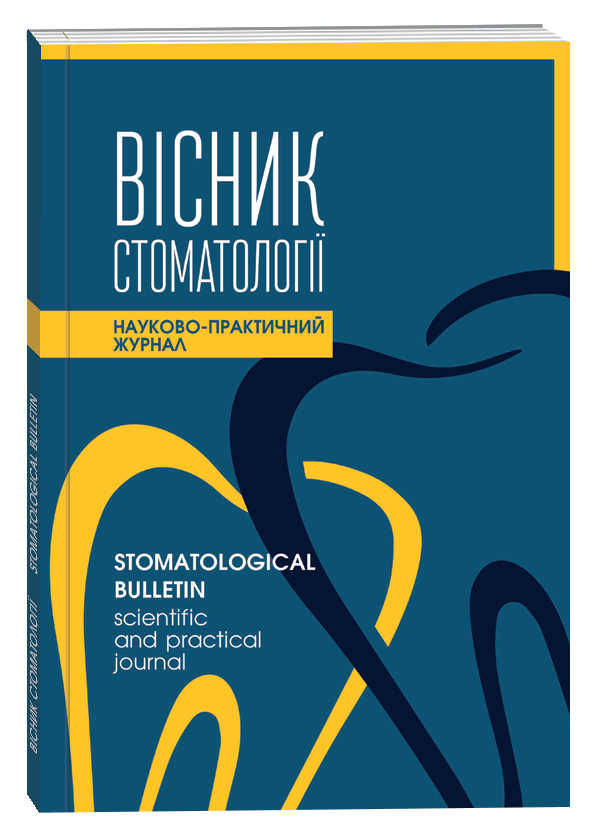CURRENT TRENDS IN PERIODONTITIS TREATMENT AND PREVENTION: A LITERATURE OVERVIEW
DOI:
https://doi.org/10.35220/2078-8916-2022-45-3.24Keywords:
periodontitis, prevention, conservative treatment, surgical treatment, hygiene.Abstract
The aim of this article is to review modern researches devoted to the study of methods of prevention and treatment of periodontitis. Results. It should be noted that the analysed scientific works only briefly touch on the issue of periodontitis prevention, noting that it depends on both oral hygiene and a person's lifestyle. To maintain healthy teeth and periodontal disease, dentists recommend: giving up smoking, eating a variety of foods, including vegetables and fruit in the diet, limiting the consumption of too cold and hot food, using dental floss and mouth rinses, choosing toothpaste and the hardness of the toothbrush taking into account the recommendations of the specialist Unfortunately, not all plaque can be removed at home. Hygiene becomes more difficult if the teeth are crowded, if there are prostheses or braces. Therefore, it is important to undergo preventive examinations every six months, not forgetting professional teeth cleaning at the dentist. Conservative treatment involves therapeutic (mechanical treatment of canals; medicinal (antiseptic) treatment of canals; if necessary, an incision to remove inflammatory products; sealing) and physiotherapeutic (UHF therapy; electrophoresis; laser therapy; therapeutic baths and pastes) procedures. Conservative treatment of periodontitis is accompanied by taking antibiotics. The surgical method of treatment involves resection of the tip of the tooth root with subsequent filling of the apical section of the canal; complete tooth root removal; tooth extraction. Due to the peculiarities of the anatomical structure of the root canals of the teeth, endodontic treatment becomes ineffective. Conclusion. At the current stage of development, the complex treatment of periodontitis has several treatment methods that combine the use of the most modern pharmaceuticals in combination with therapeutic and surgical methods, which in the future allows to obtain a fairly good and stable result.
References
Митченок О.В., Лазар А.Д., Житарюк Л.В. Сучасний погляд на консервативний хірургічний метод лікування хронічних періодонтитів. Український стоматологічний альманах. 2013. №. 2. С. 94-96.
Mann J, Bernstein Y, Findler M. Periodontal disease and its prevention, by traditional and new avenues. Exp Ther Med. 2020. 19(2). P. 1504-1506. doi: 10.3892/ etm.2019.8381
Kim WJ, Soh Y, Heo SM. Recent Advances of Therapeutic Targets for the Treatment of Periodontal Disease. Biomol Ther (Seoul). 2021. 29(3). P. 263-267. doi: 10.4062/biomolther.2021.001
Kwon T., Lamster I., Levin L. Current Concepts in the Management of Periodontitis. International Dental Journal. 2021. Volume 71, Issue 6. P. 462-476. https://doi. org/10.1111/idj.12630
Nazir MA. Prevalence of periodontal disease, its association with systemic diseases and prevention. Int J Health Sci (Qassim) 2017. 11. P. 72–80
Jain, P., Pundir, R. Recent Trends in Prevention and Treatment of Dental Caries and Periodontal Disease by Natural Plant Products. Recent Trends in Biotechnology and Therapeutic Applications of Medicinal Plants. P.109-129. DOI:10.1007/978-94-007-6603-7_6
Condò SG, DeVizio W, Volpe AR. Gingiva, teeth and sea salt. Am J Dent. 1999. 12. P. 5–8.
Горова А.І., Колесник В.Є., Павличенко А.В. Моделювання впливу забрудненості довкілля на здоров’я людини. Довкілля та здоров’я. 2006. № 4. С. 3-7.
Шевченко І.Б. Порівняльна характеристика консервативно-хірургічних методів лікування хронічних періодонтитів у хворих різних вікових груп: автореф. дис. на здобуття наук. ступеня канд. мед. наук: спец. 14.00.21 „Стоматологія”. Полтава, 1999. 17 с.









